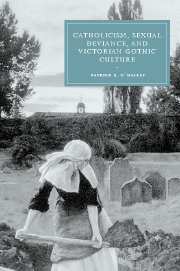Book contents
- Frontmatter
- Contents
- List of illustrations
- Acknowledgments
- Introduction: skeletons in the cloister
- 1 Goths and Romans: the literature of Gothic from Radcliffe to Ruskin
- 2 “The Church's closet”: Victorian Catholicism and the crisis of interpretation
- 3 Domestic Gothic: unveiling Lady Audley's Secret
- 4 The blood of the saints: vampirism from Polidori to Stoker
- 5 “Monstrous and terrible delight”: the aesthetic Gothic of Pater and Wilde
- 6 Conclusions: Oxford's ghosts and the end of the Gothic
- Notes
- Works cited
- Index
- CAMBRIDGE STUDIES IN NINETEENTH-CENTURY LITERATURE AND CULTURE
4 - The blood of the saints: vampirism from Polidori to Stoker
Published online by Cambridge University Press: 06 July 2010
- Frontmatter
- Contents
- List of illustrations
- Acknowledgments
- Introduction: skeletons in the cloister
- 1 Goths and Romans: the literature of Gothic from Radcliffe to Ruskin
- 2 “The Church's closet”: Victorian Catholicism and the crisis of interpretation
- 3 Domestic Gothic: unveiling Lady Audley's Secret
- 4 The blood of the saints: vampirism from Polidori to Stoker
- 5 “Monstrous and terrible delight”: the aesthetic Gothic of Pater and Wilde
- 6 Conclusions: Oxford's ghosts and the end of the Gothic
- Notes
- Works cited
- Index
- CAMBRIDGE STUDIES IN NINETEENTH-CENTURY LITERATURE AND CULTURE
Summary
Before, I looked upon the accounts of vice and injustice, that I read in books or heard from others, as tales of ancient days, or imaginary evils; at least they were remote, and more familiar to reason than to the imagination; but now misery has come home, and men appear to me as monsters thirsting for each other's blood.
Mary Shelley, Frankenstein (1818)The “woman drunken with the blood of the saints” (Rev. xvii. 6) has not lost her cruel nature … Her persecuting laws are still the same as when in the Dark Ages her infernal Inquisition performed, unhindered, its bloodthirsty work.
Walter Walsh, The Secret History of the Oxford Movement (1897)Published in the same year as Bram Stoker's Dracula, Walter Walsh's attack on Catholicism uses the imagery of the Revelation of St. John the Divine to make of the Roman Church a type of vampire. Unlike Stoker's protagonist, Walsh's vampiric Church is feminine rather than masculine, and the metaphor is motivated not only through reference to the Gothic trope of “infernal Inquisition” but also through allusion to sexual deviance: in Revelation the “woman drunken with the blood of the saints” is the infamous Whore of Babylon:
And there came one of the seven angels which had the seven vials, and talked with me, saying unto me, Come hither; I will shew unto thee the judgment of the great whore that sitteth upon many waters: With whom the kings of the earth have committed fornication, and the inhabitants of the earth have been made drunk with the wine of her fornication. […]
- Type
- Chapter
- Information
- Catholicism, Sexual Deviance, and Victorian Gothic Culture , pp. 130 - 164Publisher: Cambridge University PressPrint publication year: 2006



